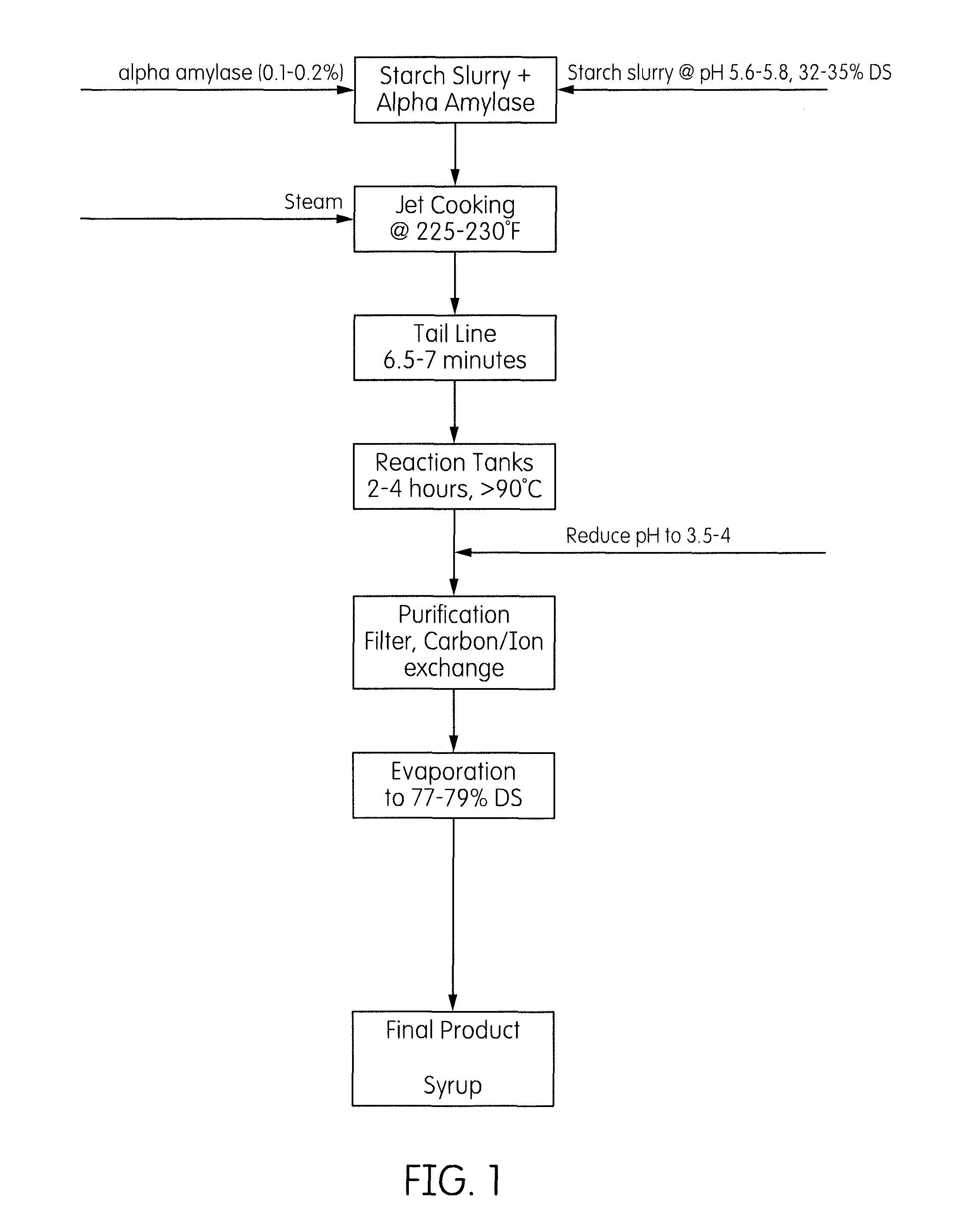Reduced sugar syrups and methods of making reduced sugar syrups
a technology of sugar syrup and syrup, which is applied in the field of sugar syrup, can solve the problems of large change in the colligative properties of sugar syrup, high sugar content consumer products have come under wide criticism for purported links to obesity and associated health conditions, and high sugar content, so as to promote the rupture and dissolution of starch granules, the effect of high shear
- Summary
- Abstract
- Description
- Claims
- Application Information
AI Technical Summary
Benefits of technology
Problems solved by technology
Method used
Image
Examples
example 1
[0072]15 kg of starch slurry (35% DS dent starch) was adjusted to pH 5.8 using 4M NaOH. 5.25 g of Veretase® enzyme (Verenium Corporation) (0.1% w / w starch dsb) was added to the slurry. The slurry was jet cooked at 107° C. with a 6-7 min residence time in the tail pipe. The jetted starch was collected and allowed to stir in a round bottom flask maintained at 85-90° C. Samples were collected for saccharide distribution analysis over time. The reaction was carried out for 3 hours and then killed by reducing the pH to 3 and cooling the syrup. The syrup was then filtered through Celite® filter aid and passed through activated carbon and ion exchange resin for purification. The syrup was then evaporated to 80% DS.
[0073]Table 1A shows the saccharide distribution of the reaction samples taken at different time intervals. Table 1B provides the molecular weight and polydispersity data for each sample.
TABLE 1ATime, minDP1DP2DP3DP4DP5DP6DP7DP8DP9DP10DP11DP12DP13+00.353.063.62.582.164.186.885.36...
example 2
15 kg of starch slurry (35% DS dent starch) was adjusted to pH 5.3 using 4M NaOH. 5.25 g of Veretase® enzyme (0.1% w / w starch dsb) was added to the slurry. The slurry was jet cooked at 107° C. with a 6-7 min residence time in the tail pipe. The jetted starch was collected and allowed to stir in a round bottom flask maintained at 85-90° C. Samples were collected for saccharide distribution analysis over time. The reaction was carried out for 3 hours and then killed by reducing the pH to 3 and cooling the syrup. The syrup was then filtered through Celite and passed through activated carbon and ion exchange resin for purification. The syrup was then evaporated to 80% DS.
[0075]Table 3 shows the saccharide distribution of the reaction samples taken at various times.
TABLE 3Time,(min)DextroseDP2DP3DP4DP5DP6DP7DP8DP9DP10DP11DP12DP13+00.563.764.273.22.725.177.986.055.525.2155.7300.986.436.815.284.598.812.238.096.475.24.3830.7601.288.248.236.485.710.9714.667.996.235.094.4820.52901.519.479.057...
example 3
[0076]Dent starch (5.25 kg) was mixed with 9.75 kg water to make a 35% DS starch slurry. The pH of the slurry was adjusted to 5.9 using 10% NaOH. 5.25 g of Veretase® enzyme was added to the slurry. The slurry was then jet cooked at 107° C. at a rate of 350 mL / min, which provides a residence time in the tail of 6-7 minutes. The liquefact was collected and cooled to 65° C. in a water bath. After cooling, 10.5 g of Grindamyl® PowerFresh 3001 enzyme (Danisco) was added to the syrup. Samples of the reaction mixture were collected at different time intervals. After 3 hours, the reaction was stopped by reducing the pH to 4. Table 4 shows the saccharide distribution of the reaction samples taken at different times. The time “t=0” is the time at which jetting (liquefaction) had been completed and the Grindamyl® enzyme was added.
[0077]By way of comparison, when a typical liquefact prepared by jet cooking a starch slurry using a conventional heat-stable alpha amylase (e.g., those that produce ...
PUM
| Property | Measurement | Unit |
|---|---|---|
| temperature | aaaaa | aaaaa |
| temperature | aaaaa | aaaaa |
| viscosity | aaaaa | aaaaa |
Abstract
Description
Claims
Application Information
 Login to View More
Login to View More - R&D
- Intellectual Property
- Life Sciences
- Materials
- Tech Scout
- Unparalleled Data Quality
- Higher Quality Content
- 60% Fewer Hallucinations
Browse by: Latest US Patents, China's latest patents, Technical Efficacy Thesaurus, Application Domain, Technology Topic, Popular Technical Reports.
© 2025 PatSnap. All rights reserved.Legal|Privacy policy|Modern Slavery Act Transparency Statement|Sitemap|About US| Contact US: help@patsnap.com

